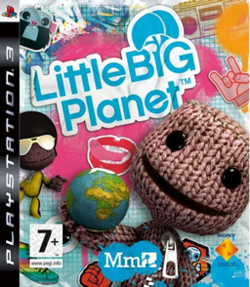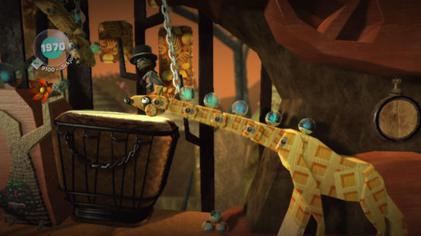In an age when video games are differentiated by specifics such as HD graphic resolution, Sony sought to take a step backwards and develop a product with broad enough appeal to attract as many consumers as possible. This challenge, however, did not rely on piecing together the ultimate gamer market segmentation report. Rather, Sony needed to create an approach that did this groundwork for them, fast. The Wii gamer segment, where users are personalizing their machines and game profiles to interact with an online community, is growing steadily and, most recently, out-sold Sony's PS3 over 4 to 1 (http://www.1up.com/do/newsStory?cId=3171305). Further, video game production costs, 3 years ago, ranged between $3 million and $6 million (http://news.bbc.co.uk/1/hi/technology/4442346.stm). Estimates today place costs upwards of $20 million. New video games, thus, need relatively strong ROI.
So, t hen, how might Sony safely reach as many customers as possible? Meet LittleBigPlanet. LBP is a world where gamers guide 'Sack puppets' through any challenges made available to them. These 'Sack people' range from being entirely new to resembling characters from various other popular games. And, of course, they can be customized.
hen, how might Sony safely reach as many customers as possible? Meet LittleBigPlanet. LBP is a world where gamers guide 'Sack puppets' through any challenges made available to them. These 'Sack people' range from being entirely new to resembling characters from various other popular games. And, of course, they can be customized. But Sony did not stop at this simple functionality, which is found in a majority of today's games. LBP is a semi-open game platform in the form of a developer's kit. Players can build their own worlds quickly, customized however they please. These worlds can then be shared online amongst the PS3 LBP community. Appropriately, LittleBigWorkshop's catch phrase is Play. Create. Share.
But Sony did not stop at this simple functionality, which is found in a majority of today's games. LBP is a semi-open game platform in the form of a developer's kit. Players can build their own worlds quickly, customized however they please. These worlds can then be shared online amongst the PS3 LBP community. Appropriately, LittleBigWorkshop's catch phrase is Play. Create. Share.
While there were 50 pre-built levels included with the game, Sony looks to the community of LBP gamers to create worlds of play applicable to their demographic or something to which their segment is emotionally tied. For example, there is an up-cropping of worlds resembling the early Mario Brothers games. This  externalization of NPD (albeit partial because gamers do not truly create an entirely new product) is apparently a fun process for the user and results in a products personalized to a broad spectrum of segments. This is not the first game to provide this capability; level building dates back to at least 1991 in a game by Epic called ZZT (http://blog.wired.com/games/2008/10/first-impressio.html). However, this does represent a shift towards NPD via social media, where gamers add value to their own community through co-creation. The result thus far, though muddled by the current recession, is reasonably good. After its launch completed early this November, LBP's sales placed it in the top 10 titles for October with only a few day's worth of availabilty accounting for that ranking (http://www.1up.com/do/newsStory?cId=3171305).
externalization of NPD (albeit partial because gamers do not truly create an entirely new product) is apparently a fun process for the user and results in a products personalized to a broad spectrum of segments. This is not the first game to provide this capability; level building dates back to at least 1991 in a game by Epic called ZZT (http://blog.wired.com/games/2008/10/first-impressio.html). However, this does represent a shift towards NPD via social media, where gamers add value to their own community through co-creation. The result thus far, though muddled by the current recession, is reasonably good. After its launch completed early this November, LBP's sales placed it in the top 10 titles for October with only a few day's worth of availabilty accounting for that ranking (http://www.1up.com/do/newsStory?cId=3171305).
Another interesting and, perhaps, more poignant insight is that this same approach and capability, including all the community communication elements, were available for PC games decades ago. Sony's LBP model is hardly a new concept for innovation. Yet, perhaps users were not yet conditioned to develop and share as readily as they are today.
Twitter Updates
Subscribe Now
Contributors
- Adam B. Needles
- Amanda Gielow
- Aric Rindfleisch
- Bjoernar
- Bob
- Bryan Streu
- ChaseEllman
- Cristy Barrera
- DylanAbruscato
- Jac_McClanathan
- Jenny Friedman
- John Rotheray
- Justin Meister
- Katie Lorenz
- Kelli Kottke
- L. Novy
- Lacey Carlstrom
- Liz Prinz
- Marie Haas
- Matt Preston
- Michelle Zeasman
- Neena Amarnani
- Patrick Lueck
- Paul Lenser
- Sam
- Sasha
- StartPointMKT
- TJ
- Tara S.
- Tyler
- Vanessaf
- Wendy
- Wing
- WisconsInnovation
- hnag
- kkautza
- krs1234
- mbaran
- pspaulding
- samiii
- tlaughland
Followers
Other Innovation Blogs
- BakerBots
- Better Projects
- Confused of Calcutta
- Experience Curve
- Frank Pillar
- Future Lab
- Garuv Bhalla
- Girish Mallapragada
- Henry Jenkins
- Inventor Spot
- Joel West
- Make Magazine
- Marketing on Demand
- Nigel Hollis
- Patty Seybold
- People Inspired Innovation
- Propelling Brands
- Putting People First
- Rob Kozinets
- Science Progress
- Seth Godin
- Sun Microsystems
- The MaRS Blog
- Wendy Soucie
Cool Links
Blog Archive
-
▼
2008
(42)
-
▼
December
(19)
- Crowdsourcing Scientific Discovery
- Co-Creation in Education
- Kimberly-Clark Revamps Depends
- NYT's 8th Annual Year in Ideas
- Innovation is a Habit
- Find a need and fill it
- Communication Revolution
- Don't Read This...Really...I'm Warning You...
- Twittering for Customer Insights
- Microsoft Sure Can Innovate! ...Or Maybe Not?
- A Real Tree?
- Packaging innovation at McDonald's
- Tesla Motors
- Beware of Alliances: The Dark Side of Collaboratin...
- Playing For Change: Peace Through Music
- Nike Zoom LeBron VI "Big Apple"
- Feel Free to Share
- Let’s ask ChaCha
- Another Example of Co-CreationI thought I would gi...
-
▼
December
(19)
Labels
- 3D Printing (3)
- 3D Scanning (1)
- A Million Penguins (1)
- Abortion (1)
- Advertising (1)
- Advertising Age (1)
- Alexa (1)
- Amazon (1)
- Android (1)
- Apple (1)
- art (2)
- augmented reality (1)
- Autodesk (1)
- Automobile. Mitsubishi (1)
- Automobile. Telsa (1)
- Automobole (1)
- Baseball (2)
- Beer (1)
- birds (1)
- blank-label (1)
- Blogger.com (1)
- Branding (2)
- Business (1)
- Business and Economy (1)
- Business-to-business (1)
- Business-to-consumer (1)
- Changing Consumers (1)
- Charity (1)
- Christmas (1)
- clusters (1)
- Co-creation (14)
- Coca-cola (1)
- Collaboration (5)
- Columbia University (1)
- Community (2)
- Computers (2)
- Consumer behavior (1)
- Consumer Development Kits (1)
- CPG (1)
- crowdsourcing (6)
- Customer Co-Creation (3)
- Customer Toolkits (2)
- Dance (2)
- Design (2)
- Developing World (2)
- Digg.com (1)
- DIY (1)
- DNA (1)
- Dropbox (1)
- Dunkin' Donuts (1)
- ebooks (1)
- Economic development (1)
- Economist (1)
- Education (1)
- EMC (1)
- Ethics (1)
- Facebook (4)
- Failure (1)
- file sharing (1)
- Fonera Fon (1)
- Frank Lloyd Wright (1)
- Future (2)
- General Mills (1)
- Gifts (1)
- Global for Me (1)
- globalization (1)
- Google (4)
- Groundswell (1)
- Groupon (1)
- Hackers (2)
- Halloween (1)
- HP (1)
- http://www.businesspundit.com/the-unique-origins-of-25-popular-products/ (1)
- http://www.econtalk.org/archives/2009/03/wales_on_wikipe.html (1)
- IBM (1)
- incubator kitchen (1)
- IndieGoGo (1)
- Information graphics (1)
- InnoCentive (2)
- Innovation (20)
- Instant Replay (1)
- Insurance (1)
- Internet marketing (2)
- interview (1)
- Ipad (1)
- iPhone (2)
- Japanese (1)
- Jive (1)
- John Howe (1)
- Jupiter Research (1)
- Kickstarter (1)
- Kindle (1)
- Kinect (2)
- lead user (1)
- Legislation (1)
- Lego (3)
- Linux (2)
- Little Big Planet (1)
- Local Motors (4)
- LuminAid (1)
- Madison (1)
- Madison Wisconsin (1)
- Makerbot (1)
- mapping (1)
- Marketing (1)
- Materialism (1)
- Matt Rutledge. Amazon. (1)
- Medical (1)
- Mercedes-Benz (1)
- Microsoft (4)
- MindTouch (1)
- Minneapolis (1)
- MIT (1)
- mobile marketing (1)
- Motorcycle (1)
- Mozy (1)
- music (5)
- MySpace (1)
- nature (1)
- NBC (1)
- New product development (1)
- New York (1)
- New York Times (1)
- NPD (2)
- online community (2)
- Open Innovation (3)
- Open-source (7)
- opensource (1)
- Paint (1)
- Piracy (1)
- pop culture (1)
- Presentation (1)
- Prezi.com (1)
- Procter and Gamble (1)
- Project (1)
- Raspberry Pi (1)
- recession (1)
- Reddit.com (1)
- Robert W. Baird (1)
- Robot (1)
- Rockmelt (1)
- science (1)
- sector 67 (1)
- sharing (2)
- social media (8)
- social networking (6)
- software (2)
- Sony (1)
- SOPA (2)
- Starbucks (1)
- storage (1)
- Sustainability (3)
- tattoo (1)
- technology (3)
- TED (2)
- ten thousand cents (1)
- Texts from last night (1)
- Threadless (1)
- Thrive (1)
- Ticketmaster (1)
- tinkering (3)
- Toilet (1)
- Toto (1)
- Toyota (1)
- Tumblr (1)
- TV (1)
- Twitter (3)
- United States (1)
- Universiity of Wisconsin-Madison (1)
- US Goverment (2)
- User Innovation (1)
- user-generated content (4)
- video (1)
- video games (3)
- Web 2.0 (1)
- wendy soucie (4)
- White House (1)
- WIFI (1)
- Wikipedia (1)
- Wikipepdia (1)
- Wired (1)
- Wisconsin (1)
- Woot.com (2)
- Xbox (2)
- Yahoo (1)
- YouTube (1)
Great post Miles! This is a wonderful example of customer co-creation (Tinkering, I believe). There is also something inherently appealing about these sackpeople. It will be interesting to see both what types of tinkering ensues as well as how Sony uses theswe creations as ideas and input for future new product releases.
Very interesting Miles. The world of gaming offers so many opportunities for collaboration and co-creation. For instance, Nintendo created Wii Ware which is an online distribution channel for independent developers to release small budget games for the Wii. Nintendo charges $2K for the developer kit and approves all material before release. So far, this has created some really innovative titles like World of Goo and Lost Winds.
Very interesting... i am inspired to think about the Wii, and wondering the playing with Wii, i mean the process, more engaging and a kind of co-creation of fun by game and players...
Great post! I think gaming world is an unlimited world of creation.
Anyway, if you have time, take a visit to my Free Games website.